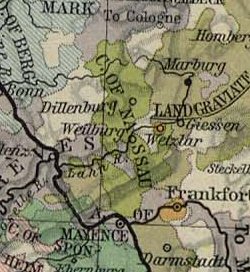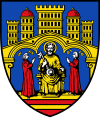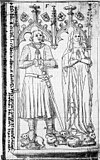
A | B | C | D | E | F | G | H | CH | I | J | K | L | M | N | O | P | Q | R | S | T | U | V | W | X | Y | Z | 0 | 1 | 2 | 3 | 4 | 5 | 6 | 7 | 8 | 9
(Princely) County of Nassau Principalities of Nassau | |||||||||
|---|---|---|---|---|---|---|---|---|---|
| 1125–1806 | |||||||||
 County of Nassau in 1547 | |||||||||
| Status | County | ||||||||
| Capital | Nassau | ||||||||
| Common languages | German (Rhine Franconian dialects, Moselle Franconian dialects) | ||||||||
| Religion | Roman Catholic | ||||||||
| Government | County | ||||||||
| Historical era | Middle Ages | ||||||||
• City founded | 915 | ||||||||
• Rupert I claims title of count | 1125 | ||||||||
• Comital title acknowledged | 1159 | ||||||||
• Partitioned multiple times | 1255–1806 | ||||||||
• Remaining parts unified to form duchy | 1806 | ||||||||
| |||||||||
| Today part of | Germany | ||||||||

The County of Nassau was a German state within the Holy Roman Empire and later part of the German Confederation. Its ruling dynasty, the male line of which is now extinct, was the House of Nassau.
Origins
Nassau, originally a county, developed on the lower Lahn river in what is known today as Rhineland-Palatinate. The town of Nassau was founded in 915.[1] Dudo of Laurenburg held Nassau as a fiefdom as granted by the Bishopric of Worms. His son, Rupert, built the Nassau Castle there around 1125, declaring himself "Count of Nassau". This title was not officially acknowledged by the Bishop of Worms until 1159 under the rule of Rupert's son, Walram. By 1159, the County of Nassau effectively claimed rights of taxation, toll collection, and justice, at which point it can be considered to become a state.[1]
The Nassauers held the territory between the Taunus and the Westerwald at the lower and middle Lahn. By 1128, they acquired the bailiwick of the Bishopric of Worms, which had numerous rights in the area, and thus created a link between their heritage at the lower Lahn and their possessions near Siegen. In the middle of the 12th century, this relationship was strengthened by the acquisition of parts of the Hesse-Thüringen feudal kingdom, namely the Herborner Mark, the Kalenberger Zent and the Court of Heimau (Löhnberg). Closely linked to this was the "Lordship of Westerwald", also in Nassau's possession at the time. At the end of the 12th century, the House acquired the Reichshof Wiesbaden, an important base in the southwest.
In 1255, after the Counts of Nassau acquired the estates of Weilburg, the sons of Count Henry II divided Nassau for the first time. Walram II received the county of Nassau-Weilburg. From 1328 on, his younger brother, Otto I, held the estates north of the Lahn river, namely the County of Nassau-Siegen and Nassau-Dillenburg. The boundary line was essentially the Lahn, with Otto receiving the northern part of the county with the cities of Siegen, Dillenburg, Herborn and Haiger and Walram retaining the section south of the river, including the cities of Weilburg and Idstein.
County of Nassau-Weilburg
Walram's son Adolf became King of Germany in 1292. His son Count Gerlach abdicated in 1344 and the county was divided under his sons in 1355
- County of Nassau-Weilburg, again divided from 1442 to 1574
- County of Nassau-Saarbrücken (Elder)
- County of Nassau-Weilburg
- County of Nassau-Wiesbaden, again divided from 1480 to 1509
- County of Nassau-Idstein
- County of Nassau-Wiesbaden
fell back to Nassau-Weilburg in 1605
- County of Nassau-Sonnenberg, partitioned among Nassau-Wiesbaden and Nassau-Weilburg in 1405
In 1605, all parts of Nassau-Weilburg were again unified under Count Louis II; however, after his death in 1627, his sons divided the county again
- County of Nassau-Idstein, fell to Nassau-Ottweiler in 1721
- County of Nassau-Saarbrücken (Younger), divided again in 1640
- County of Nassau-Saarbrücken, fell to Nassau-Ottweiler in 1723
- County of Nassau-Ottweiler, fell to Nassau-Usingen in 1728
- County of Nassau-Usingen, Principality in 1688
- County of Nassau-Weilburg (Younger)
After Nassau-Usingen had inherited Nassau-Ottweiler with former Nassau-Idstein and Nassau-Saarbrücken, it was reunified with Nassau-Weilburg and raised to the Duchy of Nassau in 1806.
County of Nassau-Dillenburg
After the death of Count Otto I, his county was divided between his sons in 1303:
- County of Nassau-Dillenburg, fell to Nassau-Siegen in 1328
- County of Nassau-Hadamar (Elder), fell to Nassau-Dillenburg in 1394
- County of Nassau-Siegen, called Nassau-Dillenburg from 1328 on, again got divided from 1341 to 1561:
- County of Nassau-Beilstein (Elder)
- County of Nassau-Dillenburg (Elder)–1606)
In 1504, Henry III of Nassau-Dillenburg inherited the county's estates at Breda in the Duchy of Brabant, while his younger brother William became Count of Nassau-Dillenburg in 1516. After the son of Henry III, René of Châlon died in 1544, Count William's eldest son William the Silent became Prince of Orange and Lord of Breda, Stadtholder in the Low Countries from 1559 on. His younger brother, John VI, again reunited all Nassau-Dillenburg possessions in 1561, though the county was again divided after his death in 1606.
- County of Nassau-Hadamar (Younger), Principality in 1650, fell to Nassau-Diez in 1743
- County of Nassau-Siegen, (1607–23), again got divided from 1623 to 1734:
- County of Nassau-Siegen (Protestant), Principality in 1664, became extinct in 1734
- County of Nassau-Siegen (Catholic), Principality, fell to Nassau-Diez in 1743
- County of Nassau-Dillenburg, fell to Nassau-Beilstein in 1620
- County of Nassau-Beilstein (Younger), called Nassau-Dillenburg (Younger) from 1620 on, Principality in 1652, fell to Nassau-Dietz in 1739
- County of Nassau-Dietz, fell to Joachim Murat's Grand Duchy of Berg after the dissolution of the Holy Roman Empire in 1806
The Counts of Nassau-Dietz, descendants of William Frederick were stadtholders of Friesland, Groningen and Drenthe and Princes of Orange from 1702 on. When they lost their Dutch possessions during the Napoleonic Wars, they were compensated with the Principality of Nassau-Orange-Fulda. Though they lost their German possessions in 1806, the House of Orange-Nassau, through female succession, was the reigning house of the Grand Duchy of Luxembourg until 1890 and is still the royal house of the Netherlands.
Rulers
House of Nassau
Partitions of Nassau under House of Nassau rule
| County of Laurenburg/ Nassau (1093-1255) | |||||||||||||||||||||||||||||
 County of Northern Nassau (Ottonian Line) (1255-1303) |
 County of Southern Nassau (Walramian Line) (1255-1355) | ||||||||||||||||||||||||||||
| County of Dillenburg (1st creation) (1303-1328) |
County of Hadamar (1st creation) (1303-1394) | ||||||||||||||||||||||||||||
| County of Beilstein (1343-1561) |
|||||||||||||||||||||||||||||
| County of Sonnenberg (1355-1404) |
|||||||||||||||||||||||||||||
 County of Weilburg (1355-1806) | |||||||||||||||||||||||||||||
| County of Siegen (1303-1652/64) |
 Barony of Breda (1403-1544) Renamed as:  Principality of Orange-Nassau (1st creation, Siegen-Breda line) (1544-1702)[2] |
County of Wiesbaden-Idstein (1st creation) (1355-1605) (divided 1370-86; 1480-1509; 1554-56; 1564-66) | |||||||||||||||||||||||||||
 County of Saarbrücken (1st creation) (1429-1574) | |||||||||||||||||||||||||||||
| County of Hadamar (2nd creation) (1620-1650) Raised to: Principality of Hadamar (1650-1711) |
(In 1623 divided in Catholic and Protestant ruling lines) Both lines raised to: Catholic Principality of Siegen (1652-1743) and  Protestant Principality of Siegen (1664-1734) |
||||||||||||||||||||||||||||
| County of Idstein (2nd creation) (1627-1688) Raised to: Principality of Idstein (1688-1721) | |||||||||||||||||||||||||||||
| County of Ottweiler (1659-1721) |
|||||||||||||||||||||||||||||
 County of Dillenburg (2nd creation) (1606-1654) Raised to:  Principality of Dillenburg (1654-1739) |
|||||||||||||||||||||||||||||
 County of Dietz (1606-1654) Raised to:  Principality of Dietz (1654-1702) |
 County of Saarbrücken (2nd creation) (1627-1728) | ||||||||||||||||||||||||||||
Renamed as: Principality of Orange-Nassau (2nd creation, Dietz line) (1702-1806) |
County of Usingen (1659-1688) Raised to: Principality of Usingen (1688-1806) | ||||||||||||||||||||||||||||
| Principality of Saarbrücken (1741-1797) | |||||||||||||||||||||||||||||
| Annexed by France | |||||||||||||||||||||||||||||
 Principality of Orange-Nassau (2nd creation, Dietz line) (1813-1815) |
Duchy of Nassau (1806-1866) | ||||||||||||||||||||||||||||
| Annexed by Prussia | |||||||||||||||||||||||||||||
Table of rulers
| Ruler | Born | Reign | Ruling part | Consort | Death | Notes | |
|---|---|---|---|---|---|---|---|
| Dudo | ? | 1093 – 1117 | County of Laurenburg/ Nassau |
Irmgard/Demudis of Arnstein three children |
c.1117 | Founder of the family and the county. | |
| Rupert I | c.1090 First son of Dudo and Irmgard/Demudis of Arnstein |
1117 – 1154 | County of Laurenburg/ Nassau |
Beatrix of Limburg before 1135 four children |
c.1154 aged c.63/64 |
Sons of Dudo, ruled jointly. Arnold abdicated from the co-regency. | |
| Arnold I | c.1090 Second son of Dudo and Irmgard/Demudis of Arnstein |
1117 – 1148/50 | Unmarried | c.1148/50 aged c.58-60 | |||
| Rupert II | c.1120 First son of Rupert I and Beatrix of Limburg |
1154 – 1159 | County of Laurenburg/ Nassau |
Beatrix at least two children |
c.1159 aged c.38-39 |
Sons of Rupert I, ruled jointly. | |
| Arnold II | c.1137 Second son of Rupert I and Beatrix of Limburg |
Unknown at least one child |
c.1159 aged c.21-22 | ||||
| Regency of Beatrix of Limburg (1159-1160) | Cousins, ruled together. Rupert III, Arnold II's son, co- ruled with Henry I, Rupert II's son. In 1167, Henry I died in Rome during the August 1167 epidemic (after the Battle of Monte Porzio). His death made his brother Waleran replace him in the co-regency. In 1191, Rupert III's death made his son Herman the new co-regent, but he abdicated the next year. In 1193, Waleran I (then already sole ruler) would become the first legalized Count of Nassau. | ||||||
| Rupert III the Bellicose | c.1130/40? Son of Arnold II |
1159 – 23/28 December 1191 | County of Laurenburg/ Nassau |
Elysa of Leiningen 1169 two children |
23/28 December 1191 aged c.51-61 | ||
| Henry I | c.1140 First son of Rupert II and Beatrix |
1159 – August 1167 | Unmarried | August 1167 Rome aged c.26/27 | |||
| Waleran I | 1146 Second son of Rupert II and Beatrix |
August 1167 – 1 February 1198 | Kunigunde of Ziegenhain before 1135 four children |
1 February 1198 aged 51/52 | |||
| Herman | c.1170 Son of Rupert III and Elysa of Leiningen |
23/28 December 1191 – 1192 | Unmarried | c.1210? aged c.39/40? | |||
| Henry II the Rich | c.1180 First son of Waleran I and Kunigunde of Ziegenhain |
1 February 1198 – 26 April 1250 | County of Nassau | Matilda of Guelders before 1221 eleven children |
26 April 1250 aged c.69/70 |
Sons of Waleran I, ruled together. From 1230 to 1240, Rupert was a Knight of the Teutonic Order. | |
| Rupert IV | c.1180 Second son of Waleran I and Kunigunde of Ziegenhain |
1 February 1198 – 1230 | Gertrude of Isenburg-Cleeberg c. 11 December 1215 no children |
c.1239 aged c.58/59 | |||
| Henry II's sons, Waleran II and Otto I, who were ruling together, split the Nassau possessions on 17 December 1255, by a treaty called Prima divisio, which determined the Lahn river as border of the two halves: to the south, called Southern Nassau, was ruled by Waleran and his descendants, who became known as the Walramian Line, which became important in the County of Nassau and Luxembourg; to the north, called Northern Nassau the county was ruled by Otto and his descendants, who became known as the Ottonian Line, which would inherit parts of Nassau, France and the Netherlands. | |||||||
| Waleran II | 
|
c.1220 First son of Henry II and Matilda of Guelders |
26 April 1250 – 16 December 1255 | County of Nassau | Adelaide of Katzenelnbogen before 1250 seven children |
24 January 1276 aged c.55/56 |
Children of Henry II, ruled jointly until 1255, when they issued the Prima divisio, regulating their division of lands:
|
| 16 December 1255 – 24 January 1276 | Southern Nassau | ||||||
| Otto I | 1224 Second son of Henry II and Matilda of Guelders |
26 April 1250 – 16 December 1255 | County of Nassau | Agnes of Leiningen before 1270 five children |
between 3 May 1289 and 19 March 1290 aged c.64-66 | ||
| 16 December 1255 – 1289/90 | Northern Nassau | ||||||
| Adolph I | 
|
1255 Second son of Waleran II and Adelaide of Katzenelnbogen |
24 January 1276 – 2 July 1298 | County of Southern Nassau | Imagina of Isenburg-Limburg 1270 eight children |
2 July 1298 Göllheim aged 42/43 |
In 1292 was crowned King of Germany. |
| Henry I[3] | 
|
c.1270 First son of Otto I, Count of Nassau and Agnes of Leiningen |
1289/90 – 1303 | County of Northern Nassau | Adelaide of Sponheim-Heinsberg 1302 five children |
July/August 1343 aged 72/73 |
Sons of Otto I, ruled together until 1303, when they divided the land: Henry received Nassau-Siegen
(Siegen, Ginsberg, Haiger, and the Westerwald), Emicho received Nassau-Hadamar and John received Nassau-Dillenburg. However, after the childless death of John, Nassau-Dillenburg (and the towns of Dillenburg, Herborn, and Beilstein) fell to Nassau-Siegen, which adopted the name Nassau-Dillenburg. Siegen and Dillenburg were united until 1606. |
| 1303 – July/August 1343 | County of Siegen | ||||||
| Emicho I | c.1285 Second son of Otto I, Count of Nassau and Agnes of Leiningen |
1289/90 – 1303 | County of Northern Nassau | Anna of Nuremberg before 1297 eight children |
7 June 1334 aged 48-49 | ||
| 1303 – 7 June 1334 | County of Hadamar | ||||||
| John | c.1285 Fourth son of Otto I, Count of Nassau and Agnes of Leiningen |
1289/90 – 1303 | County of Northern Nassau | Unmarried | 10 August 1328 aged 42-43 | ||
| 1303 – 10 August 1328 | County of Dillenburg | ||||||
| Nassau-Dillenburg was annexed to Nassau-Siegen | |||||||
| Imagina of Isenburg-Limburg | 
|
1255 Limburg an der Lahn Daughter of Gerlach IV, Count of Isenburg-Limburg and Imagina of Blieskastel |
2 July 1298 – 29 September 1313 | County of Southern Nassau (at Weilburg) |
Adolph I 1270 eight children |
29 September 1313 Wiesbaden aged 57–58 |
While Adolf's widow, Imagina, received a seat at Weilburg (which after her death returned to the family), the children of the couple ruled jointly. Waleran abdicated in 1316, and in 1344 Gerlach did the same to pass the rule to his two elder sons, as his brothers didn't have male heirs. |
| Rupert V | 1280 Second son of Adolph I and Imagina of Isenburg-Limburg |
2 July 1298 – 2 November 1304 | County of Southern Nassau | Unmarried | 2 November 1304 aged 23/24 | ||
| Gerlach I | 
|
1285 Third son of Adolph I and Imagina of Isenburg-Limburg |
2 July 1298 – 1344 | Agnes of Hesse 1307 seven children Irmgard of Hohenlohe-Weikersheim before 4 January 1337 two children |
7 January 1361 Wiesbaden-Sonnenberg (?) aged 75/76 | ||
| Waleran III | 1294 Fifth son of Adolph I and Imagina of Isenburg-Limburg |
2 July 1298 – 1316 | Unmarried | 22 December 1324 aged 29/30 | |||
| John | c.1305 First son of Emicho I and Anna of Nuremberg |
7 June 1334 – 20 January 1365 | County of Hadamar | Elisabeth of Waldeck 1331 ten children |
20 January 1365 aged c.59/60 |
Children of Emicho I, ruled jointly. | |
| Emicho II | c.1305 Second son of Emicho I and Anna of Nuremberg |
7 June 1334 – 1 March 1359 | Anna of Diez no children |
1 March 1359 aged c. 53/54 | |||
| Otto II | 
|
1305 First son of Henry I and Adelaide of Sponheim-Heinsberg |
July/August 1343 – December 1350 or January 1351 | County of Siegen | Adelaide of Vianden 23 December 1331 three children |
December 1350/January 1351 |
Children of Henry I, divided the land: Otto inherited Siegen and Dillenburg, and Henry inherited Beilstein, partitioned from Dillenburg. |
| Henry I | 1307 Second son of Henry I and Adelaide of Sponheim-Heinsberg |
July/August 1343 – 28 October 1378 | County of Beilstein | Imagina of Westerburg 1339 three children |
28 October 1378 Beilstein aged 70/71 | ||
| Adelaide of Vianden | 
|
c.1310 Daughter of Philip II, Count of Vianden and Adelaide of Arnsberg |
December 1350 or January 1351 – 30 September 1376 | County of Siegen (in Mengerskirchen and Tringenstein) |
Otto II 23 December 1331 three children |
30 September 1376 Mengerskirchen (?) aged c.65/66 |
Heirs of Otto II. Adelaide, as Otto's widow, received seats Mengerskirchen and Tringenstein, while serving also as regent for her son John. After John attained majority, she continued her rule in her designated seats. During his long reign, John made lucrative acquisitions of various kinds and expanded the possessions of his family. |
| Regency of Adelaide of Vianden (1351-1362) | |||||||
| John I | 1339 Son of Otto II and Adelaide of Vianden Zdroj:https://en.wikipedia.org?pojem=Nassau-Dillenburg Text je dostupný za podmienok Creative Commons Attribution/Share-Alike License 3.0 Unported; prípadne za ďalších podmienok. Podrobnejšie informácie nájdete na stránke Podmienky použitia.
Analytika
Antropológia Aplikované vedy Bibliometria Dejiny vedy Encyklopédie Filozofia vedy Forenzné vedy Humanitné vedy Knižničná veda Kryogenika Kryptológia Kulturológia Literárna veda Medzidisciplinárne oblasti Metódy kvantitatívnej analýzy Metavedy Metodika Text je dostupný za podmienok Creative
Commons Attribution/Share-Alike License 3.0 Unported; prípadne za ďalších
podmienok. www.astronomia.sk | www.biologia.sk | www.botanika.sk | www.dejiny.sk | www.economy.sk | www.elektrotechnika.sk | www.estetika.sk | www.farmakologia.sk | www.filozofia.sk | Fyzika | www.futurologia.sk | www.genetika.sk | www.chemia.sk | www.lingvistika.sk | www.politologia.sk | www.psychologia.sk | www.sexuologia.sk | www.sociologia.sk | www.veda.sk I www.zoologia.sk | ||||||

